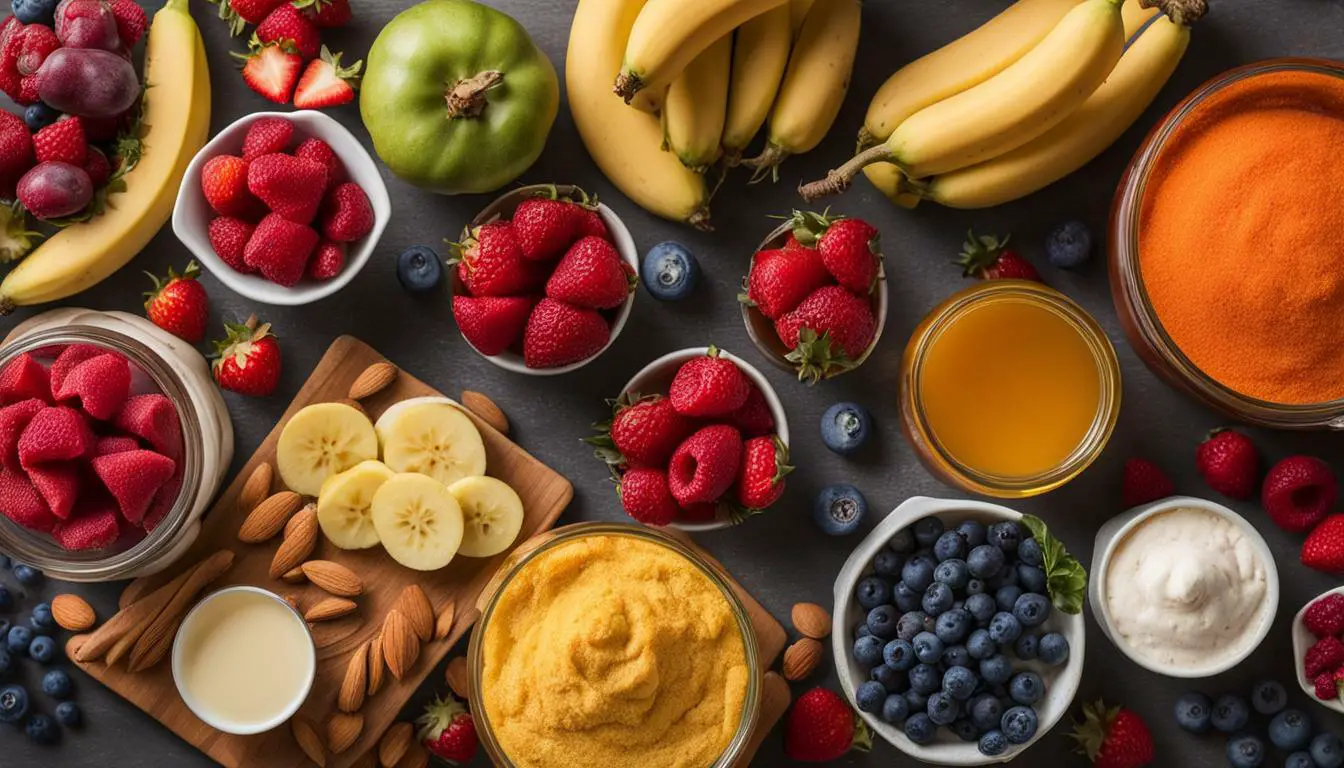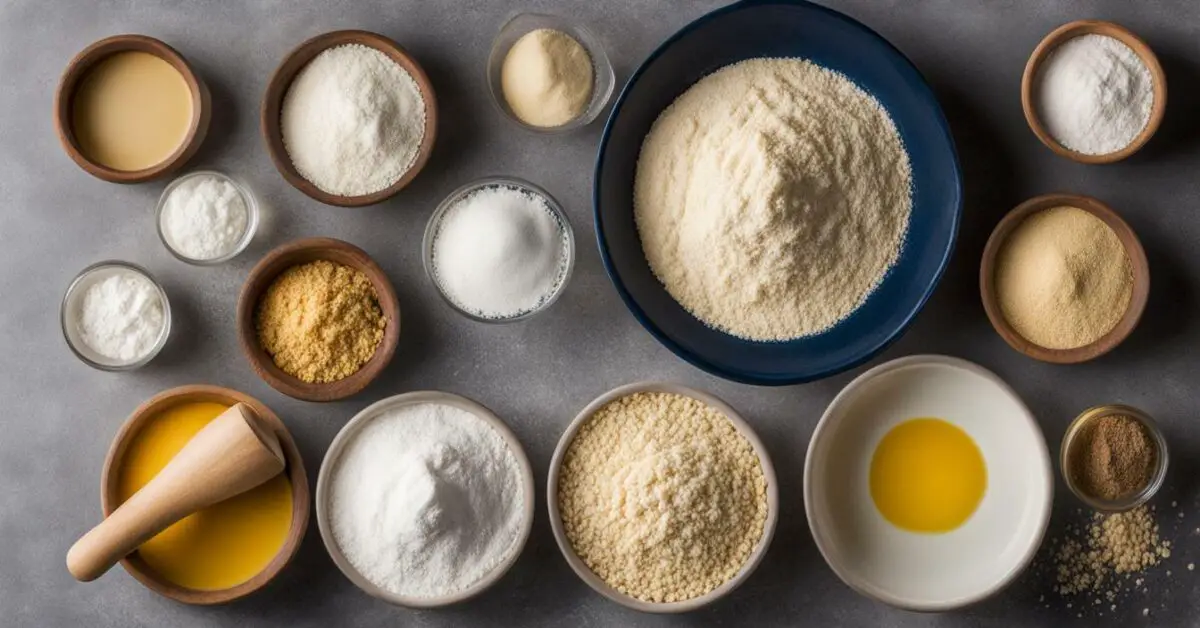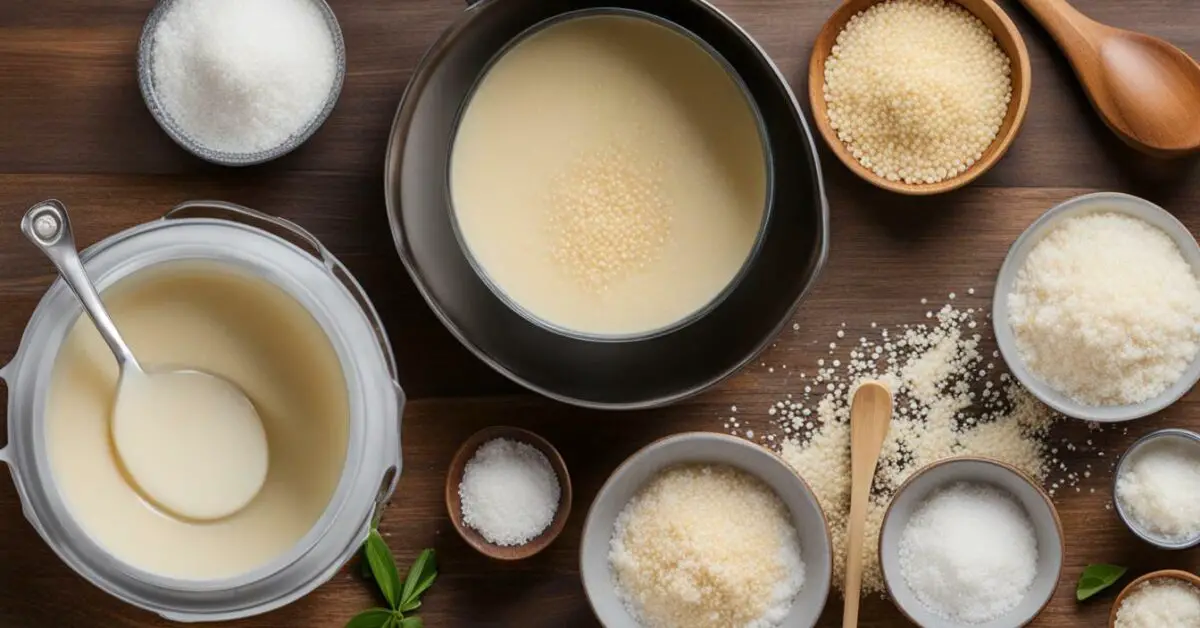
This post may contain affiliate links. Please read my disclosure for more information.
Looking for a substitute for cornstarch in your syrup? Here are the 10 best alternatives that will help you achieve the desired texture and thickness.
Key Takeaways:
- Potato Starch can be used in equal amounts as cornstarch, offering a similar texture and neutral flavor.
- All-Purpose Flour can act as a thickening agent, but won’t provide the same glossy shine as cornstarch. Use twice as much flour as cornstarch.
- Arrowroot Powder has the same thickening power as cornstarch and can create a glossy sauce. Dissolve it in cold water before adding it to your sauces.
- Rice Flour can be substituted for cornstarch by using two tablespoons of rice flour for every one tablespoon of cornstarch. It also adds a satisfyingly crunchy texture in fried foods.
- Tapioca Flour should be used twice the amount as cornstarch, but be careful not to overheat or boil for too long as it can become gummy.
Potato Starch
When you need a cornstarch substitute in your syrup, potato starch can be a great option due to its similar texture and neutral taste. It offers a smooth and creamy consistency, making it an excellent thickening agent. You can use potato starch in equal amounts as cornstarch in your syrup recipes.
Potato starch is derived from potatoes and is naturally gluten-free, making it a suitable choice for those with dietary restrictions. It blends well with other ingredients and does not alter the flavor of your syrup. Whether you’re making homemade pancake syrup or a fruity compote, potato starch can help you achieve the desired thickness without compromising on taste.
Table: Comparison of Potato Starch with Cornstarch
| Property | Potato Starch | Cornstarch |
|---|---|---|
| Texture | Similar | – |
| Taste | Neutral | – |
| Gluten-free | Yes | Yes |
Incorporating potato starch into your syrup is simple. Dissolve the desired amount of potato starch in a small amount of cold water to create a slurry. Gradually pour the slurry into your simmering syrup while stirring continuously. Allow the syrup to cook for a few more minutes, and you’ll notice it thickening up beautifully, just like if you were using cornstarch.
Whether you’re following a gluten-free diet or simply want to try something different, potato starch is a versatile substitute for cornstarch in syrup. Experiment with different quantities to achieve your desired consistency, and enjoy the delicious results in your favorite sweet dishes.
All-Purpose Flour
If you don’t have cornstarch on hand, you can use all-purpose flour as a substitute in syrup, although it may not give the same glossy finish. All-purpose flour can still act as a thickening agent and help to achieve the desired consistency in your syrups. However, it’s important to note that using flour as a substitute may result in a slightly different texture in your final dish.
When substituting all-purpose flour for cornstarch in syrup, you’ll need to use twice as much flour. For example, if a recipe calls for 1 tablespoon of cornstarch, you’ll need to use 2 tablespoons of flour. This will help compensate for the differences in thickening power between the two ingredients.
Table: Cornstarch Substitute Ratio
| Cornstarch | All-Purpose Flour |
|---|---|
| 1 tablespoon | 2 tablespoons |
| 2 tablespoons | 4 tablespoons |
| 1/4 cup | 1/2 cup |
Keep in mind that while all-purpose flour can substitute for cornstarch in syrup, it may alter the overall texture of your dish. Cornstarch typically provides a smoother, glossier finish. If this is an important aspect of your recipe, you may want to consider using one of the other alternatives mentioned in this article.
Experimenting with different substitutes can help you discover new flavors and textures in your sweet dishes. Whether you choose all-purpose flour or another alternative, the key is to find the right balance that complements your recipe and suits your personal taste preferences.
Arrowroot Powder: A Glossy Substitute for Cornstarch in Syrup
For a cornstarch alternative with a glossy sauce outcome, arrowroot powder can be a suitable option when making syrup. This fine white powder, derived from the arrowroot plant, has the same thickening power as cornstarch and is known for its ability to create a glossy texture in sauces and syrups.
To use arrowroot powder as a substitute for cornstarch in syrup, dissolve it in cold water before adding it to your sauces. This helps prevent clumping and ensures a smooth consistency. For each tablespoon of cornstarch called for in your recipe, you can use an equal amount of arrowroot powder.
How to Use Arrowroot Powder in Syrup:
- Dissolve arrowroot powder in cold water, using a ratio of one tablespoon of powder for each tablespoon of cornstarch.
- Add the dissolved arrowroot mixture to your syrup while it is cooking, stirring continuously.
- Continue to cook the syrup until it reaches the desired thickness. Arrowroot powder thickens quickly, so monitor the consistency closely.
Arrowroot powder is an excellent alternative for those seeking a cornstarch substitute in syrup. Its neutral taste and glossy texture make it a versatile ingredient for various sweet dishes. Moreover, it is gluten-free, making it suitable for individuals with dietary restrictions.
| Advantages | Disadvantages |
|---|---|
| Creates a glossy sauce | May be more expensive than cornstarch |
| Neutral flavor | Less readily available in stores |
| Gluten-free |
Overall, arrowroot powder is a fantastic option when you want to substitute cornstarch in syrup. Its ability to thicken and create a glossy texture makes it a reliable choice for enhancing your sweet dishes. Experiment with arrowroot powder in different recipes and enjoy the delightful results it brings to your homemade syrups.
Rice Flour: A Crunchy Substitute for Cornstarch in Syrup
If you prefer a crunchy texture in your syrup, rice flour can be a great substitute for cornstarch. This gluten-free alternative adds a delightful crispiness to your dishes while still providing the desired thickness. To use rice flour as a substitute for cornstarch in syrup, simply replace every one tablespoon of cornstarch with two tablespoons of rice flour.
Rice flour is particularly suitable for recipes that require frying, as it creates a satisfyingly crispy coating. Whether you’re making sweet fritters or indulging in crispy treats, rice flour can help you achieve that irresistible crunch.
Using Rice Flour as a Cornstarch Substitute
When using rice flour in your syrup recipes, it’s important to note that it doesn’t have the same thickening power as cornstarch. Therefore, you’ll need to use twice as much rice flour to achieve the desired consistency. It’s also recommended to dissolve the rice flour in a small amount of cold water before adding it to your sauces or syrups. This step helps prevent clumping and ensures a smooth texture.
Keep in mind that rice flour may not be the best substitute if you’re looking for a glossy finish, as it doesn’t provide the same shine as cornstarch. However, its unique crunchiness and gluten-free properties make it an excellent option for those with dietary restrictions or a preference for crispy textures.
| Advantages of Rice Flour | Considerations when using Rice Flour |
|---|---|
| Gluten-free alternative | Doesn’t provide a glossy finish |
| Creates a crunchy texture | Requires double the amount compared to cornstarch |
| Perfect for frying or crispy dishes | Needs to be dissolved in cold water before use |
In summary, rice flour is a fantastic substitute for cornstarch in syrup if you desire a crunchy texture. While it may not provide the same glossy appearance, its gluten-free nature and ability to create crispy coatings make it an excellent option. Remember to use twice as much rice flour as cornstarch and dissolve it in cold water before adding it to your syrups or sauces.
Tapioca Flour: A Perfect Substitute for Cornstarch in Syrup
Tapioca flour can be used as a cornstarch substitute in syrup by using twice the amount, but make sure to avoid overcooking to prevent a gummy texture. Tapioca flour, derived from the cassava root, offers a similar thickening power and is an excellent alternative for those looking to avoid cornstarch for dietary or allergy reasons. With its unique ability to create a smooth and glossy sauce, tapioca flour is a versatile option that can be used in various sweet dishes.
When substituting cornstarch with tapioca flour, use twice the amount specified in the recipe. For example, if a recipe calls for one tablespoon of cornstarch, use two tablespoons of tapioca flour. However, it is important to note that tapioca flour has a lower heat tolerance than cornstarch, so it’s crucial to avoid overcooking or boiling the syrup for too long. Overheating tapioca flour can result in a gummy or slimy texture, which is not desirable in syrup preparations.
If you’re looking for a gluten-free alternative to cornstarch, tapioca flour is a fantastic choice. Not only does it offer the desired thickening properties, but it also adds a pleasant chewiness to the final product. Tapioca flour works exceptionally well in fruit-based syrups, such as berry compotes or fruit sauces, where its slightly sweet flavor complements the natural sweetness of the fruits.
Summary:
Tapioca flour is an excellent substitute for cornstarch in syrup. By using twice the amount, you can achieve similar thickening results. However, be cautious not to overcook the syrup, as it can lead to a gummy texture. Tapioca flour is a gluten-free option that adds a pleasant chewiness to sweet dishes. It works particularly well in fruit-based syrups and compliments their natural sweetness.
| Substitute | Usage | Texture |
|---|---|---|
| Potato Starch | Equal amounts as cornstarch | Similar to cornstarch |
| All-Purpose Flour | Twice as much as cornstarch | Thickening, but less glossy |
| Arrowroot Powder | Dissolve in cold water before adding | Glossy sauce texture |
| Rice Flour | Double the amount of cornstarch | Crunchy texture in fried foods |
| Tapioca Flour | Twice the amount of cornstarch | Similar thickening power, watch for overcooking |
| Xanthan Gum | Start with a small amount, add more as needed | Powerful thickening agent |
| Instant Pudding Mix | No-cook option for sweet syrups | Ideal for making pastry cream or whipped cream |
| Glucomannan, Ground Flaxseeds, Guar Gum | Some alternatives, but may affect texture and flavor | Use with caution |
| Cassava Flour | Not as thickening as cornstarch, but suitable for certain recipes | Variable texture |
| Wheat Flour | Can be used, but may result in denser and tougher final product | Use sparingly |
Xanthan Gum and Other Alternatives
In addition to the aforementioned substitutes, xanthan gum is a powerful thickening agent commonly used in gluten-free baking, making it a viable alternative for cornstarch in syrup. Derived from the fermentation of corn sugar, xanthan gum is known for its ability to improve the texture and consistency of various recipes.
When using xanthan gum as a substitute for cornstarch in syrup, it’s important to start with a small amount and gradually add more as needed. This will help prevent an overly thick or gummy texture. Xanthan gum can be dissolved in a cold liquid before adding it to your syrup, ensuring even distribution and optimal results.
Although xanthan gum can provide a similar thickening effect as cornstarch, it’s worth noting that other alternatives like instant pudding mix, glucomannan, ground flaxseeds, and guar gum are also mentioned by some sources. However, these alternatives may introduce different textures and flavors to your syrup, so caution should be exercised when using them.
| Xanthan Gum | Instant Pudding Mix | Glucomannan | Ground Flaxseeds | Guar Gum |
|---|---|---|---|---|
| A powerful thickening agent commonly used in gluten-free baking. | Can be used to thicken sweet syrups without cooking. | An alternative that can yield different textures and flavors. | May introduce a slight nutty flavor to your syrup. | Use with caution due to differences in texture and flavor. |
Summary
In summary, when seeking alternatives to cornstarch in syrup, xanthan gum offers a suitable thickening option, particularly for gluten-free recipes. However, alternatives like instant pudding mix, glucomannan, ground flaxseeds, and guar gum should be used judiciously due to potential variations in texture and flavor. By knowing your options and experimenting with these substitutes, you can achieve the desired consistency and enhance the taste of your sweet dishes.
Conclusion
In conclusion, there are numerous substitutes for cornstarch in syrup, each with its texture and properties. Experiment with these alternatives to find the perfect fit for your recipe and elevate your sweet dishes.
Potato starch is an excellent substitute for cornstarch in syrup, offering a similar texture and neutral flavor. Use it in equal amounts as cornstarch to achieve the desired thickening effect.
All-purpose flour can act as a thickening agent in syrup, but it won’t provide the same glossy shine as cornstarch. Remember to use twice as much flour as cornstarch when substituting.
Arrowroot powder has the same thickening power as cornstarch and can create a glossy sauce. Dissolve it in cold water before adding it to your sauces for the best results.
Rice flour is another alternative that can be used in a ratio of two tablespoons of rice flour for every one tablespoon of cornstarch. It not only adds thickness but also provides a satisfyingly crunchy texture in fried foods.
When substituting with tapioca flour, use twice the amount as cornstarch. However, be cautious not to overheat or boil for too long, as it can become gummy.
Xanthan gum, often used in gluten-free baking recipes, can also be used as a substitute for cornstarch in syrup. Start with a small amount and add more as needed to achieve the desired consistency.
Other alternatives like instant pudding mix, glucomannan, ground flaxseeds, and guar gum may also be used, but they may not provide the exact texture and can introduce unwanted flavors. Use them with caution.
While cassava flour is not as effective as cornstarch in thickening syrups, it can still be used in some recipes where consistency is not crucial.
Lastly, wheat flour can be used as a substitute, but it may make the final product dense and tough if too much is added. Use it sparingly and adjust accordingly.
With these alternatives at your disposal, you can confidently substitute cornstarch in syrup and create delicious sweet dishes without compromising on taste or texture.
FAQ
Can I use potato starch as a substitute for cornstarch in syrup?
Yes, potato starch offers a similar texture and neutral flavor, making it an excellent substitute for cornstarch in syrup. You can use it in equal amounts as cornstarch.
Can I use all-purpose flour as a substitute for cornstarch in syrup?
Yes, all-purpose flour can act as a thickening agent in syrup. However, it won’t provide the same glossy shine as cornstarch. Use twice as much flour as cornstarch when substituting.
What is the role of arrowroot powder in substituting cornstarch in syrup?
Arrowroot powder has the same thickening power as cornstarch and can create a glossy sauce. To use it as a substitute, dissolve it in cold water before adding it to your sauces.
How can I substitute cornstarch with rice flour in syrup?
Substitute two tablespoons of rice flour for every one tablespoon of cornstarch to achieve the desired thickness. Rice flour also provides a satisfyingly crunchy texture in fried foods.
Is tapioca flour a suitable substitute for cornstarch in syrup?
Yes, tapioca flour can be used as a substitute, but you’ll need to use twice the amount of tapioca flour as cornstarch. Be cautious not to overheat or boil for too long, as it can become gummy.
Can I use xanthan gum as a substitute for cornstarch in syrup?
Yes, xanthan gum is a powerful thickening agent often used in gluten-free baking recipes. Start with a small amount and add more as needed. Other alternatives like instant pudding mix, glucomannan, ground flaxseeds, and guar gum may also be used, but they may not provide the exact texture and can introduce unwanted flavors.
What are other alternatives for cornstarch in syrup?
Some other alternatives include instant pudding mix, glucomannan, ground flaxseeds, and guar gum. However, it’s important to note that these substitutes may not give the same texture and can have unwanted flavors.
Can I use cassava flour as a substitute for cornstarch in syrup?
Cassava flour is not as thickening as cornstarch, but it can be used in some recipes if consistency is not crucial.
Can I use wheat flour as a substitute for cornstarch in syrup?
Yes, wheat flour can be used as a substitute, but be cautious as it may make the final product dense and tough if too much is added.


